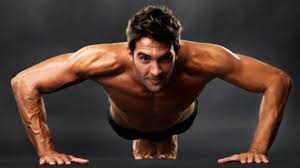
While many don’t consider the pushup a technical exercise, we can apply the principles of basic athletic skills—moving with posture, load, and torque – in a way that elevates this exercise to something that can improve our running.
You’re probably wondering, “But how can good pressing mechanics improve my running?”
Pushups tell us a lot about how we run. It’s important to have good posture when performing the pushup in order for the shoulders to be strong and stable. A “soft” butt and belly destabilizes the pelvis, the low back arches, and our shoulders become unstable. Remember, you play how you practice. Runners who perform “soft” pushups with overextended posture also tend to run soft and overextended. This disconnection contributes to a whole host of problems, including low back pain, IT band pain, collapsed arches and a clipped running stride. Performing a better pushup addresses these issues.
Pushups also reveal a lot about your arm swing. Specifically, an elbow-in pushup promotes shoulder stability and range of motion in the joint. This position and mobility transfers to a “north-south” arm swing with a good elbow drive. Doing pushups with the elbows flared out promoted an unstable and internally rotated shoulder position. This poor position surfaces as a stiff and inefficient “east-west” arm swing when you run, where the elbows drive across the body.
Let’s perform a simple exercise. Using your phone, or having a friend watch you, film yourself doing 5 pushups with good form. Is “good” form subjective and open to interpretation?
Let’s look at the pushup using the same skill-based approach we used for the squat.
1. Posture
As with the squat, it’s important to move with a strong and stable spine when performing the pushup. To anchor the spine, squeeze the legs and butt tight, and keep your rib cage pulled down. This tension locks the pelvis into a good neutral position for greater trunk stability.
2. Load
Initiate with the shoulder by tipping forward to load the shoulders. At the bottom of the pushup, your forearms should be close to vertical in the same way our shins remain close to vertical in the squat.
3. Torque
In the squat, it’s important to drive the knees outward in order to add tension and stabilize the hip. This cue works because driving the knees outward rotates the leg into the hip socket—akin to tightening a screw that’s a little loose. In the pushup, we apply this same type of torque by driving the elbows inward toward the rib cage. Keeping the elbows in screws our arm into the shoulder socket in a similar manner.
After practicing these skills, film yourself again for another set of 5 pushups and compare to the first video. Notice any changes? Did you keep your forearms vertical the entire time? Were you able to drop as deep? These changes are difficult to master, but they’re important because they better position the shoulders for good pressing mechanics.
The pushup is just like the squat in that we must move with posture, load, and torque. How we perform these seemingly simple movements reveals a lot about us as athletes—a peek behind our biomechanical curtain, so to speak.
The more connections you can make between how you move and how you run, the more relevant strength training becomes to your training plan. The more aware you are of your deficiencies, the more you can learn, tweak, and improve them, and the longer you commit to this approach, the faster, farther, and more frequently you can hit the road, track and trail.
The active



